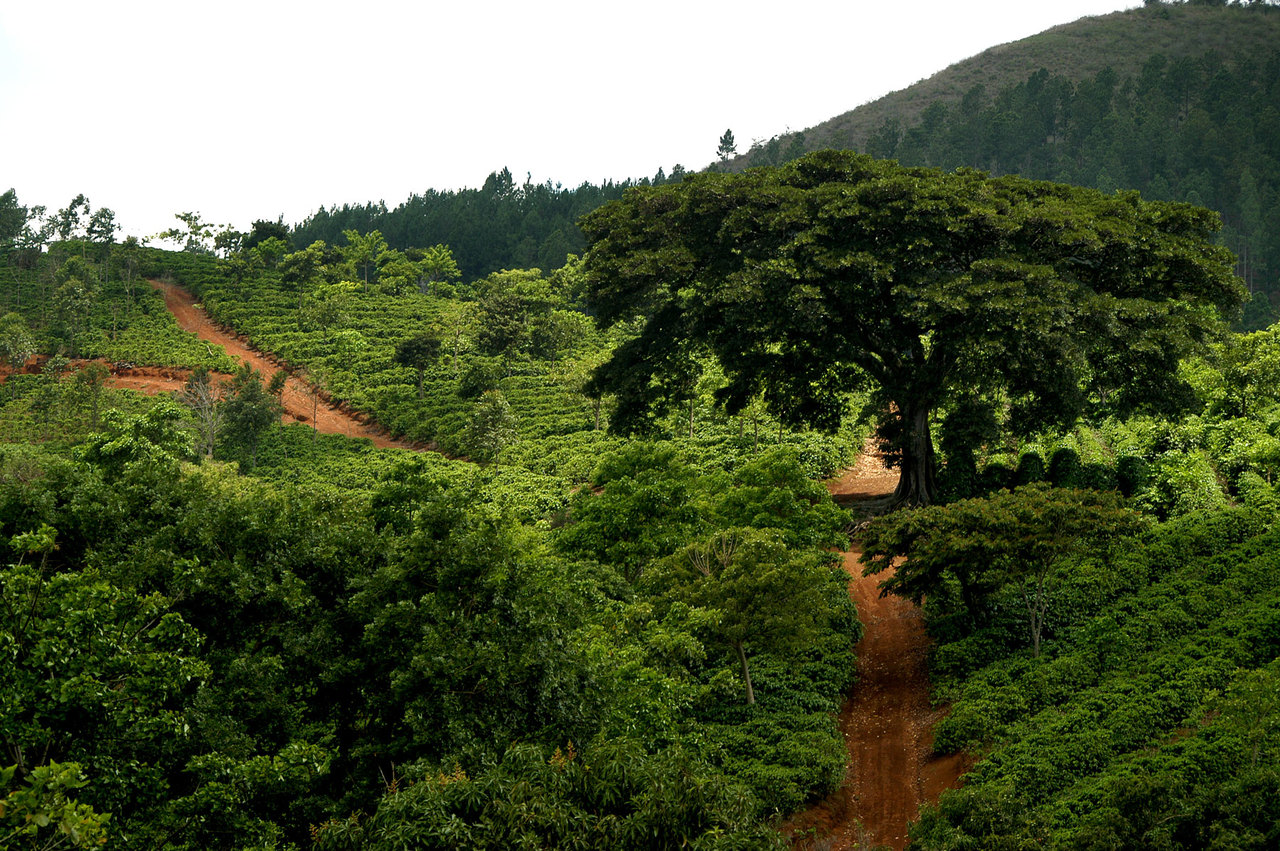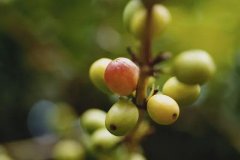The difference between Arabica and robusta coffee Arabica caffeine content is lower?

Professional coffee knowledge exchange more coffee bean information please follow the coffee workshop (Wechat official account cafe_style)
Arabica
The difference between Arabica vs Robusta Arabica coffee and Robasta coffee:
Caffeine bean is the seed of Rubiaceae Family. There are at least 25 main varieties of Coffea Genus, among which the two most important varieties are Arabica species Coffea arabica (Arabica coffee) and Canafora species Coffea canephora (Robusta coffee), also known as Robasta Coffee. Arabica coffee beans account for 70% of the world's production, Robasta coffee beans account for about 30%, Arabica coffee has 44 chromosomes, while Robasta coffee has 22 chromosomes. therefore, Arabica coffee is a crop that cannot be crossed with Robasta coffee.
Coffee trees are affected by the climate, altitude and soil quality of different regions, affecting the quality and flavor of coffee beans, such as other agricultural products, such as tea and wine. So even if you come from the same country, different regions have different flavors, and the price is naturally different. Coffee trees are evergreen plants and are cultivated in tropical and subtropical areas. the most suitable growth conditions are that there should be an appropriate amount of Rain Water and the drainage of the land is good, so they are mostly selected on sloping slopes rich in volcanic ash (rich in organic matter). Therefore, most of the high-quality Arabica coffee beans are harvested manually and carried down the mountain by horses or mules. The climate has a great impact on the price of coffee. Brazil, the world's largest coffee producer, suffered two severe frosts in 1994, causing the price of coffee beans to soar from about $1000 per metric ton to about $2400. As a result, coffee merchants are attracted to Vietnam to rush to grow coffee. Under unbridled cultivation, the price of coffee beans also collapsed, falling to just $500,600 a tonne in 2001 and 2002. In 2002, about 1 million coffee-related farmers in Central and South America lost their jobs and countless families were in trouble. (see conscience with Coffee (Ethics in your Coffee Cup))
The bean shape of Arabica coffee is small, the front is long oval, the middle split crack is narrow and tortuous, S-shaped, and the arc on the back of the bean is more complete. The bean shape of Robasta coffee bean is larger, the front tends to be round, and the split line crack in the middle is in a straight line. (the Viv Ole é Arabica coffee beans pictured below are Maragogype beans with higher grades and larger beans.)
As far as planting is concerned, Robasta coffee tree has the characteristics of high temperature resistance, cold resistance, drought resistance, moisture resistance, resistance to diseases and insect pests and strong adaptability, and can grow well on flat ground. unfortunately, the coffee beans produced are lack of aroma. Strong bitterness (because of too much caffeine), lack of acidity, so it is mostly used in instant coffee, canned coffee, or brewed three-in-one coffee. In Italy, many coffee shops add an appropriate proportion of Robusta Robasta beans to make espresso (Espresso) to enhance the "taste" (such as strong, rough, etc.).
Many people know that Arabica Coffee is famous, but they don't know the difference between Arabica Coffee and Robasta Coffee, which is commonly used in canned drinks.
Arabica Arabica Robusta Robasta
Chromosome 4422
From planting to first harvest, 4-5 years, 2-3 years.
Flowering to red fruit for 9 months, 10 to 11 months.
The ripe fruit fell and left on the branch
The highest of wild tree species is 7-12 meters and 10 meters.
Deep soil and shallow soil
The optimum growth temperature is 15-24 ℃ 24-30 ℃
Optimal rainfall 1500-2000 mm 2000-3000 mm
The optimum growth height is 900m-2000 m.
The growing environment is mild, cool, warm and humid.
The number of coffee beans produced by coffee trees is low and high
Accounts for about 70% of global output, about 30%.
Planting most organic planting commercial planting on a large scale
Most of the cultivated land is private farms, mostly controlled by multinational enterprises.
Artificial shaking machine for harvesting coffee beans
Disease resistance is weak and strong
Insect resistance is weak and strong.
Caffeine 1.1-1.7% 4.5-4.7%
Fruit characteristics of simultaneous fertilization and cross-fertilization
The fruit is yellow or red and dark red.
The shape of the bean is long oval, flat oval, spherical
The dividing line of the bean is S-shaped and straight.
The characteristics of cooking are sour and bitter
Average consistency (BODY) 1.2%, average 2.0%
The FLAVOR is good and bad.
In the end, there should always be a conclusion, perhaps it should be called the comparison of quality and quantity (quality vs. Quantity), Arabica coffee stands for [quality], while robastian coffee stands for [quantity]. When you are interested in coffee
[flavor] (Flavor) when you care, the amount of money you pay determines what kind of coffee you deserve.
How to distinguish Arabica coffee beans from Robusta coffee beans:
The shape of ◎ Arabica coffee bean is long oval and flat, with S-shaped dividing line in the middle.
◎ Robusta coffee beans are oval, spherical or nearly spherical in shape, with a straight line in the middle.
The above picture is the Maragogype image bean of Viv Ole brand.
The grade is higher and the bean shape is larger. Robusta coffee beans are round in shape.
The dividing line in the middle is straight.
Characteristics of Arabica coffee beans-Why only Arabica is often used to make boutique coffee?
Important Notice :
前街咖啡 FrontStreet Coffee has moved to new addredd:
FrontStreet Coffee Address: 315,Donghua East Road,GuangZhou
Tel:020 38364473
- Prev

Introduction to the flavor characteristics of Arabica coffee beans how much is Arabica coffee per jin?
Professional coffee knowledge exchange more coffee bean information please follow the coffee workshop (Wechat official account cafe_style) Arabica Arabica, fine coffee turquoise bioscience in the boundary, gate, class, order, family, genus, species division, do you still remember? Don't say you gave it back to the junior high school biology teacher. Several years
- Next

Coffee is divided into three original systems. What coffee beans do Starbucks use? Arabica coffee?
Professional coffee knowledge exchange more coffee bean information please follow the coffee workshop (Wechat official account cafe_style) Arabica coffee was used by Yemenis in southwestern Arabia as early as 575, and Western Europe began to drink it around 1615. Coffee was popular in continental Europe in the early 17th century, and coffee was mainly grown in America, Africa and Asia.
Related
- Detailed explanation of Jadeite planting Land in Panamanian Jadeite Manor introduction to the grading system of Jadeite competitive bidding, Red bid, Green bid and Rose Summer
- Story of Coffee planting in Brenka region of Costa Rica Stonehenge Manor anaerobic heavy honey treatment of flavor mouth
- What's on the barrel of Blue Mountain Coffee beans?
- Can American coffee also pull flowers? How to use hot American style to pull out a good-looking pattern?
- Can you make a cold extract with coffee beans? What is the right proportion for cold-extracted coffee formula?
- Indonesian PWN Gold Mandrine Coffee Origin Features Flavor How to Chong? Mandolin coffee is American.
- A brief introduction to the flavor characteristics of Brazilian yellow bourbon coffee beans
- What is the effect of different water quality on the flavor of cold-extracted coffee? What kind of water is best for brewing coffee?
- Why do you think of Rose Summer whenever you mention Panamanian coffee?
- Introduction to the characteristics of authentic blue mountain coffee bean producing areas? What is the CIB Coffee Authority in Jamaica?

